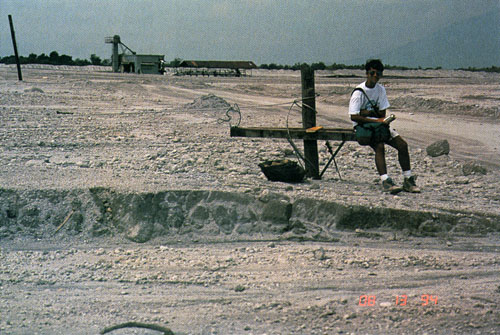sorry for lack of paragraph form, coming from a PDF it lost some of its form:
Geophysically, we begin with a pre-Flood earth differentiated into core, mantle, and crust, with the
crust horizontally differentiated into sialic craton and mafic ocean floor. The Flood was initiated as slabs
of oceanic floor broke loose and subducted along thousands of kilometers of pre-Flood continental
margins. Deformation of the mantle by these slabs raised the temperature and lowered the viscosity of
the mantle in the vicinity of the slabs. A resulting thermal runaway of the slabs through the mantle led
to meters-per-second mantle convection. Cool oceanic crust which descended to the core/mantle
boundary induced rapid reversals of the earths magnetic field. Large plumes originating near the
core/mantle boundary expressed themselves at the surface as fissure eruptions and flood basalts. Flow
induced in the mantle also produced rapid extension along linear belts throughout the sea floor and
rapid horizontal displacement of continents. Upwelling magma jettisoned steam into the atmosphere
causing intense global rain. Rapid emplacement of isostatically lighter mantle material raised the
level of the ocean floor, displacing ocean water onto the continents. When virtually all the pre-Flood
oceanic floor had been replaced with new, less-dense, less-subductable, oceanic crust, catastrophic
plate motion stopped. Subsequent cooling increased the density of the new ocean floor, producing
deeper ocean basins and a reservoir for post-Flood oceans.
Sedimentologically, we begin with a substantial reservoir of carbonate and clastic sediment in the
pre-Flood ocean. During the Flood hot brines associated with new ocean floor added precipitites to
that sediment reservoir, and warming ocean waters and degassing magmas added carbonates
especially high magnesium carbonates. Also during the Flood, rapid plate tectonics moved pre-Flood
sediments toward the continents. As ocean plates subducted near a continental margin, its bending
caused upwarping of sea floor, and its drag caused downwarping of continental crust, facilitating the
placement of sediment onto the continental margin. Once there, earthquake-induced sea waves with
ocean-to-land movement redistributed sediment toward continental interiors. Resulting sedimentary
units tend to be thick, uniform, of unknown provenance, and extend over regional, inter-regional, and
even continental areas.
After the Flood, the earth experienced a substantial period of isostatic readjustment, where local
to regional catastrophes with intense earthquake and volcanic activity were common. Post-Flood
sedimentation continued to be rapid but was dominantly basinal on the continents. Left-over heat
in the new oceans produced a significantly warmer climate just after the Flood. In the following
centuries, as the earth cooled, floral and faunal changes tracked the changing climate zonation.
The warmer oceans caused continental transport of moisture that led to the advance of continental
glaciers and ultimately to the formation of polar ice caps.
from
https://static.icr.org/i/pdf/technical/Catastrophic-Plate-Tectonics-A-Global-Flood-Model.pdf







